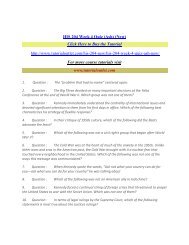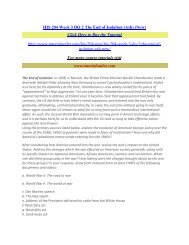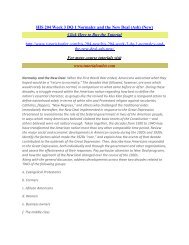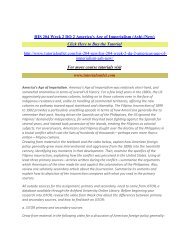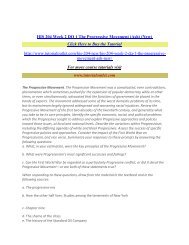HIS 204 Week 4 DQ 1 A Single American Nation (Ash) (New) / Tutorialoutlet
For more course tutorials visit www.tutorialoutlet.com A Single American Nation. When the First World War began, African-American leaders pressed the government to provide black men the right to go to combat to prove their devotion to their country. Hoping that their service would lay a stake on citizenship which the nation would have no choice but to honor, the “New Negro” of the 1920s adopted a more militant stance toward civil rights. The civil rights struggle envisioned at the time, however, made few concrete gains. Discrimination and disenfranchisement persisted. African-American leaders responded to the Second World War much as they had to the First, offering their services while expecting recognition in return. They intended to fight a “Double-V Campaign” against fascism abroad and racism at home. They helped to kill fascism abroad; racist policies at home survived, but only for a time. Less than a decade after the war ended, the Brown case struck down the principle of “separate but equal” in schools. A grass-roots movement emerged to challenge discrimination elsewhere. By 1965, nonviolent means had murdered Jim Crow. Yet, the 60s were nothing if not a violent decade, marred by war, riots, and assassinations. By the end of the decade, Americans were as divided in some ways as they had ever been, and hopes for integration into a single American nation largely gave way to an emphasis on the unique needs and interests of different groups within the nation. Chart the progress of the Civil Rights Movement from 1954 to 1965. Identifying specific events from that period, explain why the movement succeeded so well during this period when similar struggles had gained so little in previous decades. Compare and contrast the different approaches to gaining civil rights adopted by different leaders in this period, those of Martin Luther King and Malcolm X, for instance. Finally, explain why the Civil Rights Movement splintered at the end of the decade by discussing at least TWO of the following groups, drawing from the primary sources below: a. Native Americans b. Women
For more course tutorials visit
www.tutorialoutlet.com
A Single American Nation. When the First World War began, African-American leaders pressed the government to provide black men the right to go to combat to prove their devotion to their country. Hoping that their service would lay a stake on citizenship which the nation would have no choice but to honor, the “New Negro” of the 1920s adopted a more militant stance toward civil rights. The civil rights struggle envisioned at the time, however, made few concrete gains. Discrimination and disenfranchisement persisted.
African-American leaders responded to the Second World War much as they had to the First, offering their services while expecting recognition in return. They intended to fight a “Double-V Campaign” against fascism abroad and racism at home. They helped to kill fascism abroad; racist policies at home survived, but only for a time. Less than a decade after the war ended, the Brown case struck down the principle of “separate but equal” in schools. A grass-roots movement emerged to challenge discrimination elsewhere. By 1965, nonviolent means had murdered Jim Crow. Yet, the 60s were nothing if not a violent decade, marred by war, riots, and assassinations. By the end of the decade, Americans were as divided in some ways as they had ever been, and hopes for integration into a single American nation largely gave way to an emphasis on the unique needs and interests of different groups within the nation.
Chart the progress of the Civil Rights Movement from 1954 to 1965. Identifying specific events from that period, explain why the movement succeeded so well during this period when similar struggles had gained so little in previous decades. Compare and contrast the different approaches to gaining civil rights adopted by different leaders in this period, those of Martin Luther King and Malcolm X, for instance. Finally, explain why the Civil Rights Movement splintered at the end of the decade by discussing at least TWO of the following groups, drawing from the primary sources below:
a. Native Americans
b. Women
- No tags were found...
Create successful ePaper yourself
Turn your PDF publications into a flip-book with our unique Google optimized e-Paper software.
esponding to classmates, you should refer to the material from one of the sources which you<br />
did not reference in your initial post.






